1.7E: Exercises
This page is a draft and is under active development.
( \newcommand{\kernel}{\mathrm{null}\,}\)
Section Exercises
Verbal
Exercise 1.7.1
Describe why the horizontal line test is an effective way to determine whether a function is one-to-one?
- Answer:
- Each output of a function must have exactly one output for the function to be one-to-one. If any horizontal line crosses the graph of a function more than once, that means that y-values repeat and the function is not one-to-one. If no horizontal line crosses the graph of the function more than once, then no y-values repeat and the function is one-to-one.
Exercise 1.7.2
Why do we restrict the domain of the function f(x)=x2 to find the function’s inverse?
Exercise 1.7.3
Can a function be its own inverse? Explain.
- Answer:
- Yes. For example, f(x)=1x is its own inverse.
Exercise 1.7.4
Are one-to-one functions either always increasing or always decreasing? Why or why not?
Exercise 1.7.5
How do you find the inverse of a function algebraically?
- Answer:
- Given a function y=f(x), solve for x in terms of y. Interchange the x and y. Solve the new equation for y. The expression for y is the inverse, y=f−1(x).
Algebraic
Exercise 1.7.6
Show that the function f(x)=a−x is its own inverse for all real numbers a.
For the following exercises, find f−1(x) for each function.
Exercise 1.7.7
f(x)=x+3
- Answer:
- f−1(x)=x−3
Exercise 1.7.8
f(x)=x+5
Exercise 1.7.9
f(x)=2−x
- Answer:
- f−1(x)=2−x
Exercise 1.7.10:
f(x)=3−x
Exercise 1.7.11
f(x)=xx+2
- Answer:
- f−1(x)=−2xx−1
Exercise 1.7.12
f(x)=2x+35x+4
For the following exercises, find a domain on which each function f is one-to-one and non-decreasing. Write the domain in interval notation. Then find the inverse of f restricted to that domain.
Exercise 1.7.13
f(x)=(x+7)2
- Answer:
- domain of f(x): [−7,∞); f−1(x)=√x−7
Exercise 1.7.14
f(x)=(x−6)2
Exercise 1.7.15
f(x)=x2−5
- Answer:
- domain of f(x): [0,∞); f−1(x)=√x+5
Exercise 1.7.16
Given f(x)=x2+x and g(x)=2x1−x:
a. Find f(g(x)) and g(f(x)).
b. What does the answer tell us about the relationship between f(x) and g(x)?
- Answer:
- a. f(g(x))=x and g(f(x))=x.
b. This tells us that f and g are inverse functions
For the following exercises, use function composition to verify that f(x) and g(x) are inverse functions.
Exercise 1.7.17
f(x)=3√x−1 and g(x)=x3+1
- Answer:
- f(g(x))=x, g(f(x))=x
Exercise 1.7.18
f(x)=−3x+5 and g(x)=x−5−3
Graphical
For the following exercises, use a graphing utility to determine whether each function is one-to-one.
Exercise 1.7.19
f(x)=√x
- Answer:
- one-to-one
Exercise 1.7.20
f(x)=3√3x+1
Exercise 1.7.21
f(x)=−5x+1
- Answer:
- one-to-one
Exercise 1.7.22
f(x)=x3−27
For the following exercises, determine whether the graph represents a one-to-one function.
Exercise 1.7.23
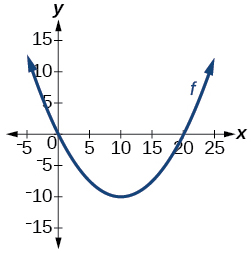
- Answer:
- not one-to-one
Exercise 1.7.24
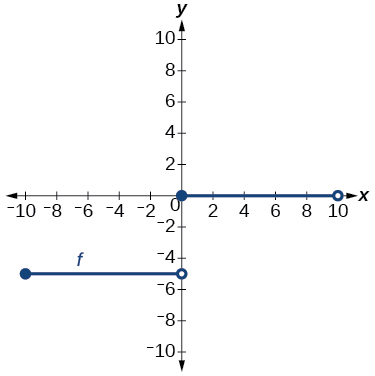
For the following exercises, use the graph of f shown in Figure 1.7.11.

Figure 1.7.11: Graph of a line
Exercise 1.7.25
Find f(0).
- Answer:
- 3
Exercise 1.7.26
Solve f(x)=0.
Exercise 1.7.27
Find f−1(0).
- Answer:
- 2
Exercise 1.7.28
Solve f−1(x)=0.
For the following exercises, use the graph of the one-to-one function shown in Figure 1.7.12.
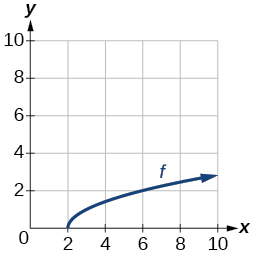
Figure 1.7.12: Graph of a square root function.
Exercise 1.7.29
Sketch the graph of f−1.
- Answer:
-
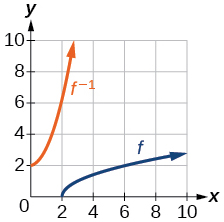
Exercise 1.7.30
Find f(6) and f−1(2).
Exercise 1.7.31
If the complete graph of f is shown, find the domain of f.
- Answer:
- [2,10]
Exercise 1.7.32
If the complete graph of f is shown, find the range of f
Numeric
For the following exercises, evaluate or solve, assuming that the function f is one-to-one.
Exercise 1.7.33
If f(6)=7, find f−1(7).
- Answer:
- 6
Exercise 1.7.34
If f(3)=2, find f−1(2).
Exercise 1.7.35
If f−1(−4)=−8, find f(−8).
- Answer:
- -4
Exercise 1.7.36
If f−1(−2)=−1, find f(−1).
For the following exercises, use the values listed in Table 1.7.6 to evaluate or solve.
| x | f(x) |
| 0 | 8 |
| 1 | 0 |
| 2 | 7 |
| 3 | 4 |
| 4 | 2 |
| 5 | 6 |
| 6 | 5 |
| 7 | 3 |
| 8 | 9 |
| 9 | 1 |
Table 1.7.6
Exercise 1.7.37
Find f(1).
- Answer:
- 0
Exercise 1.7.38
Solve f(x)=3.
Exercise 1.7.39
Find f−1(0).
- Answer:
- 1
Exercise 1.7.40
Solve f−1(x)=7.
Exercise 1.7.41
Use the tabular representation of f in Table 1.7.7 to create a table for f^{-1}(x).
|
x |
3 | 6 | 9 | 13 | 14 |
|---|---|---|---|---|---|
|
f(x) |
1 | 4 | 7 | 12 | 16 |
Table 1.7.7
- Answer:
-
x
1 4 7 12 16 f−1(x)
3 6 9 13 14
Technology
For the following exercises, find the inverse function. Then, graph the function and its inverse.
Exercise 1.7.42
f(x)=3x−2
Exercise 1.7.43
f(x)=x3−1
- Answer:
-
f−1(x)=(1+x)1/3
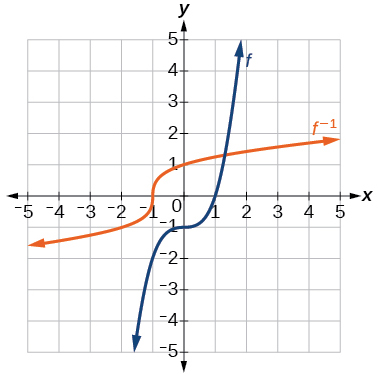
Exercise 1.7.44
Find the inverse function of f(x)=1x−1. Use a graphing utility to find its domain and range. Write the domain and range in interval notation.
Real-World Applications
Exercise 1.7.45
To convert from x degrees Celsius to y degrees Fahrenheit, we use the formula f(x)=95x+32. Find the inverse function, if it exists, and explain its meaning.
- Answer:
- f−1(x)=59(x−32). Given the Fahrenheit temperature, x, this formula allows you to calculate the Celsius temperature.
Exercise 1.7.46
The circumference C of a circle is a function of its radius given by C(r)=2πr. Express the radius of a circle as a function of its circumference. Call this function r(C). Find r(36π) and interpret its meaning.
Exercise 1.7.47
A car travels at a constant speed of 50 miles per hour. The distance the car travels in miles is a function of time, t, in hours given by d(t)=50t. Find the inverse function by expressing the time of travel in terms of the distance traveled. Call this function t(d). Find t(180) and interpret its meaning.
- Answer:
- t(d)=d50, t(180)=18050. The time for the car to travel 180 miles is 3.6 hours.

